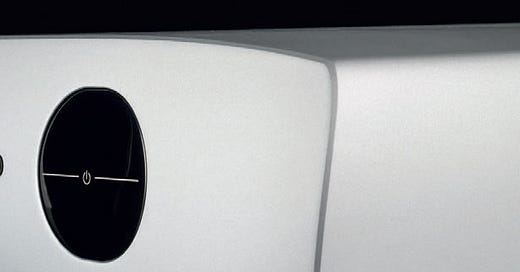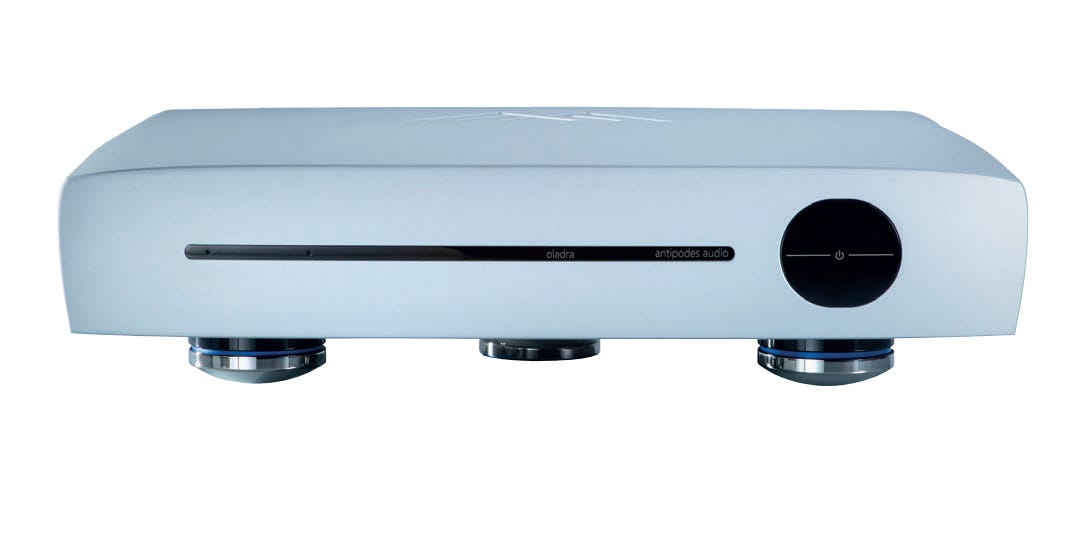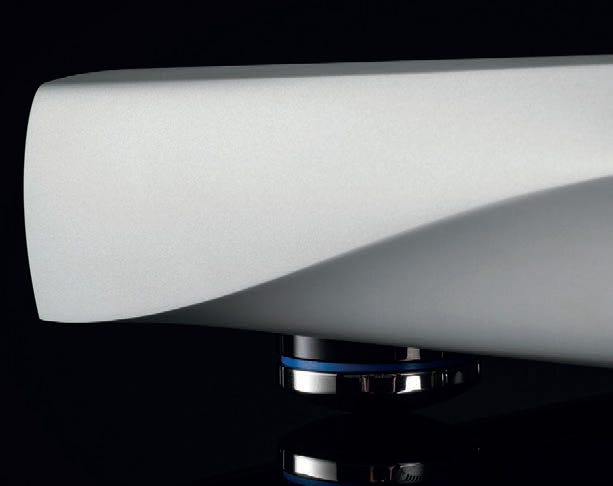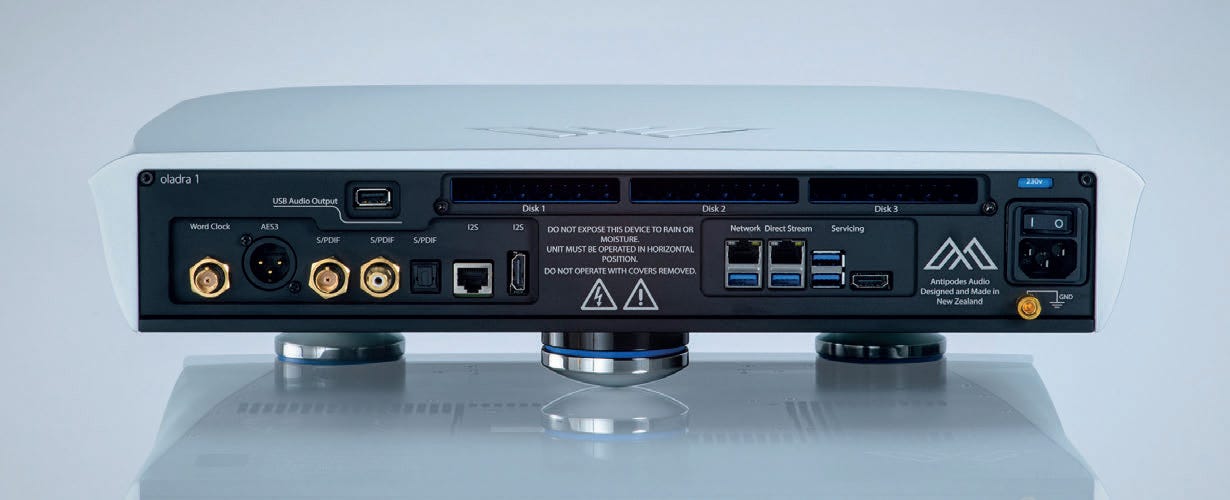Do you remember the scene from The Shining in which the late Shelley Duvall discovers the “All Work and No Play” contents of Jack Nicholson’s ‘novel’? My listening notes for the Antipodes Audio Oladra music server were a little like those typed pages, constantly returning to one phrase: It’s about time!
As the name suggests, Antipodes Audio is from the other side of the planet: Otaki on the North Island of New Zealand, ¯ some 45 miles from the capital, Wellington. Antipodes Audio is an overnight sensation in the high-end audio world. And, as with any overnight sensation, that’s based on more than 20 years of hard work. The brand has been working on computer audio since 2009 and made its first commercially available server two years later. It also operates a highend distribution agency – Emotion Audio – and an on-site demonstration facility. This is not simply a side hustle for a manufacturer but means Antipodes Audio is constantly exposed to the crucible of real-world listeners and is not walled up in an ivory tower.
Two houses…
Forgive the skewering of English grammar, but the Oladra is Antipodes Audio’s flagship servers. The singular/plural clash is deliberate because the Oladra is two music server-side products in one elegant box. The machined alloy case houses a server computer and a player computer. Chassis aside, these computers share little more than a power inlet. Both run on a Linux computer platform but with custom code for their task. This means the Antipodes Audio Oladra performs its server duties fast and reliably while the player presents the rest of your system with the best possible music source.
While ‘music server’ is not a high-pressure activity for a computer (compared to, say, an enterprise-grade device that might receive thousands of file requests every second), it is a specialist one. Separating tasks this way takes some heavy lifting from the player section, moving the needle from ‘worrying about the occasional drop-out’ to ‘maximising sonic performance’.
“Nice idea,” says the cynic, “but couldn’t this be done cheaper with just two computers?” Antipodes Audio has a Kala K41 Server and K21 player that does just that. But that’s the subject of a later review
You want options?
A music server – especially one that neatly divides between ‘server’ and ‘player’ – needs to be flexible. This is where the Emotion Audio part comes in very handy. Distributing DACs from brands such as Aavik, Ideon, and MSB (and others) means Antipodes Audio knows – first-hand –
that a case-by-case installation will outperform a more uniform approach. For Oladra, Antipodes Audio features both Server (core) and Player (endpoint) applications for Squeeze (now known as ‘Lyrion’), Roon and HQPlayer. It also includes a range of DLNA-type music servers, such as MinimServer, and MiniDLNA and Lyrion Media Server, which can be paired with MPD (a DLNA player). Oladra is JPlay certified. Any of these server apps can be streamed to compatible third-party endpoints. It might be overkill using Oladra this way, but it can even be configured as SONOS or a PLEX server.
All these options are accessible and configurable through the ‘AMS Orchestration layer’, an online dashboard for Antipodes Audio products on that local network. This flexibility of ‘back office’ core and endpoint options mean you can tailor your Oladra to suit your system perfectly. For example, someone using a Linn DS product might gravitate toward MinimServer, or a combination of MinimServer and MPD, while a dCS user might opt for LMS/Squeezeserver with Roon or Jplay (and maybe dCS Mosaic, which works exceptionally well with the Antipodes Audio system).
An advantage to the two-computer concept begins to emerge here. Sometimes, the one-hit solution isn’t the best way of doing things. For example, while there is near universal love for Roon’s endpoint software, some prefer it with another server software. That’s hard to do when using a combination of server and player. However, as the two hardware platforms are separated here, the result is a performance precisely attuned to you and your system.
Rip and store
The AMS dashboard also allows provision for bit-perfect ripping of discs. Using a third-party USB-based drive plugged into the player’s rear, the server will do all the usual tasks of cover trawling and metadata population. As a bitperfect ripper, this doesn’t allow real-time disc replay and can take a long time to work through a disc, but the results are worth the effort. Yes, many think that the ship has sailed and that Qobuz and Tidal are the way forward. And yes, most server users who claim Qobuz and Tidal are the way forward came to that conclusion after ripping about a dozen discs and deciding life is too short to carry on. But the Antipodes Audio Oladra is not most servers. Playing back those ripped discs is such a joy, you find yourself seeking out CDs to rip.
This is one of Oladra’s secret pleasures. CDs are in the same place LPs were just before the start of the vinyl revival. Back in the late 2000s, LPs were cheap. If you could get one, the LP could be bought for peanuts, and the CD would still command premium prices. Now, things are very different. CDs are remaindered, sold at a discount and fill up the shelves of charity shops and thrift stores worldwide. You can come home with a suitcase full of CDs for less than the cost of a decent dinner. Today, that same ‘decent dinner’ would net you a handful of LPs. CD is so cheap because streaming has ‘replaced’ CD… except when you rip them to your Oladra and discover just how much music CD replay left hidden in the shadows.
Storing those tracks gives you a choice of NAS drives on your local network or three rear slots for SSD storage. These narrow 2.5” SATA slots allow the user to hold up to 24TB of music across the trio of enterprise-grade solidstate drives. They are not hot-swappable, meaning if, in the unlikely event that one fails or 24TB isn’t enough, you must power down the Oladra and change drives. On the other hand, having 24TB of storage in the best possible performance means a whole music collection for most people, even if stored in uncompressed WAV files. It’s only if you have more than 5,700 SACD albums stored in uncompressed form that you might begin to need to consider other options.
It’s about time
In listening to the Antipodes Audio Oladra, it exposed a part of music that we used to take for granted when LP and tape were uppermost; timing. While the Oladra is excellent at all the usual things we come to expect from digital audio (detail, dynamic range, tonal accuracy), it’s the ability to present the music in a temporally-ordered fashion that was something more akin to good analogue than the best in digital… until now. And that hits you seconds into the first piece of music you play. It’s a ‘hang on a moment’ part, as that track gets under your skin. You don’t just hear the recording on a cerebral level; you feel it as if it’s there with you, temporally precise and focused the way nothing else can. That degree of precision to timing is more atavistic than descriptive; it’s like the difference between hearing a live band and a recording; you know instinctively that it’s a guitar, not a recording of a guitar… and the Oladra gets you closer to the original than most.
The hardest part of dealing with the Antipodes Audio Oladra is defining why it’s so good. It’s not simply about the usual audio bits; those test recordings came and went perfectly, but they were quickly proving uninformative; everything you want the music to do from an audiophile perspective, it does well, sending an uncolored, detailed, articulate and precise sound to your DAC. Your DAC becoming the main arbiter of performance given what its fed is as good as it gets. But you soon abandon those tracks just to play things for sheer enjoyment. Whether it was Chase & Status banging out some drum ‘n’ bass or Louis Armstrong playing cornet almost a century ago, it’s all about the feels, and that – above all things – is what Oladra does that others don’t!
No, it’s about time
The ability to set aside what we thought were intrinsic limitations of digital makes the Antipodes Audio Oladra something more than a music server. It makes it a time machine. You play those records from your past as if it’s the first time you heard them. You then start to appreciate music from other people’s pasts in the same way. I got more out of 1950s do-wop bands from the Antipodes Audio Oladra than I have experienced before, and they weren’t my memories, because I wasn’t around when they happened. But tracks you dig up from the past sound fresh and new.
Even your own well-worn tracks like ‘Hurricane’ by Bob Dylan sound like the first time you heard them. And that makes you remember what you were doing then, too. It’s an uncanny experience.
I risk being burned at the stake for saying this, but the Oladra makes the need to play LP become more of an ‘option’ and less of a ‘mandatory requirement.’ You don’t get the same physical contact with a digital file as with an LP. Still, in sheer musical terms, the experience of extracting musical enjoyment is at least on par with the best you can get from LP, digital discs, or even open-reel tape. I won’t labour this point as I can already hear an angry mob forming, and I’m allergic to pitchforks. Regardless, it shows how far things have moved forward with the Antipodes Audio Oladra.
The price of admission – even if you look to the Kala products rather than the Oladra – is steep until you hear what it can do. But that throws down a gauntlet for other server-side companies. How close to the Antipodes Audio Oladra’s performance can you attain at lower price points? For now, this is a question left out in the open, but the challenge is there. I doubt Oladra’s performance will be easy to replicate without the result having a similar price tag, simply because this is a lot more than a couple of computers and some SSDs in a box. But good digital audio at all levels needs a game-raiser, and the Antipodes Audio Oladra is just that.
Finally, there’s a nod to be made to Ivor Tiefenbrun of Linn Products. Half a century ago, he tore up the received wisdom of the time to stress the importance of the source component. To use a computing term; “garbage in, garbage out”; the quality of the source is the defining and limiting factor in a good audio system. Over the years, that message has been diluted somewhat thanks to outstanding audio electronics and loudspeakers. However, the Antipodes Audio Oladra proves that not only was Ivor on to something, but it still holds to this day.
Put it this way: I would rather have Oladra running a more modest system than have absolute top-end audio driven by a more off-the-shelf server. Little wonder then that the makers of those top-end components have been quietly shifting to the Oladra as part of their front-end electronics.
No, really, it’s about time
If I repeat that ‘it’s about time’ phrase, it’s for a reason. Three reasons in fact; two of which have been explained. But it is about time that the high-end took streaming
seriously. And the Antipodes Audio Oladra takes highend streaming seriously. It delivers the performance that uncompromising high-enders demand of their other formats. This means online, especially locally stored computer-based music, finally stands for something more than ‘music discovery’. Let’s not ignore the importance of Qobuz, Tidal, and even Spotify in helping us find new music. Roon’s functionality makes that great, too. But once we’ve ‘discovered’ a piece of music, genre or musician, that’s the time when the Antipodes Audio Oladra steps up. You will want to dive deep into that music, and you’ll want to do it from local storage because it sounds so genuinely fantastic. It’s also one of the few servers that deserves to be on show because it looks as good as it sounds.
The Quad Electrostatic, the Linn LP12, the Krell KSA- 50, the Wilson WATT/Puppy and Nordost Odin are among a select group of products that came to define audio performance. They were—and in many cases, still are—a standard by which musical performance in the home is measured. The Antipodes Audio Oladra joins that select group. Audio has taken a big step forward here.
Technical specifications
Type: Dedicated music server player Inputs: 2x Ethernet (RJ45), 2x USB-A
Outputs: 1x USB-A, Coaxial/RCA S/PDIF, Coaxial/BNC S/PDIF, optical S/PDIF, 1x AES3 XLR, 2x I2S (HDMI, RJ45)
Storage: 3-Bay SSD user-installable SSD Slide-Ins up to 24TB
Formats supported:
Ethernet, USB 2.0; PCM to 32/768, DoP to DSD256, native DSD to DSD512.
AES3; PCM to 24/192 and DoP to DSD64
S/PDIF; PCM to 24/192 and DoP to DSD64
I2S; PCM to 32/384, DoP to DSD256, and Native DSD to DSD512.
Finish: anodised silver or black, with polished stainless steel and chrome highlights
Dimensions (WxHxD): 44.5x8x40cm
Weight: 21kg
Price: $29,000
Manufacturer Antipodes Audio www.antipodes.audio








